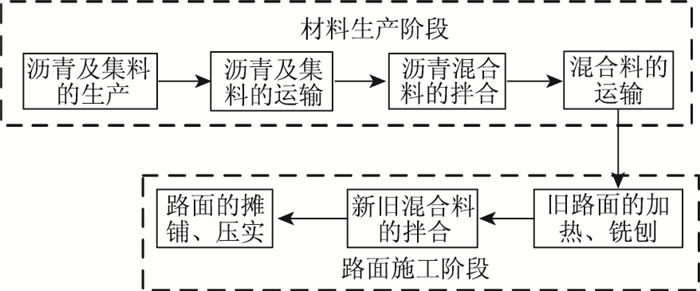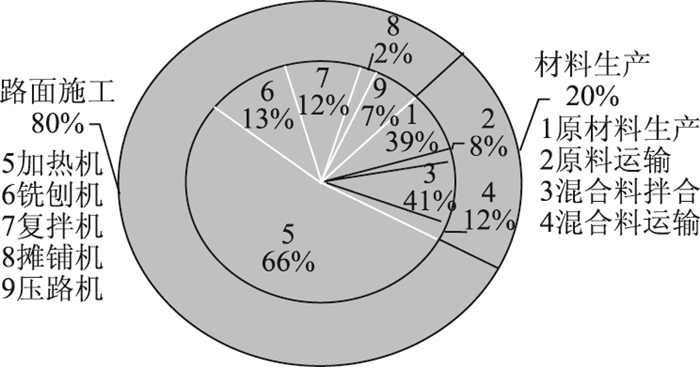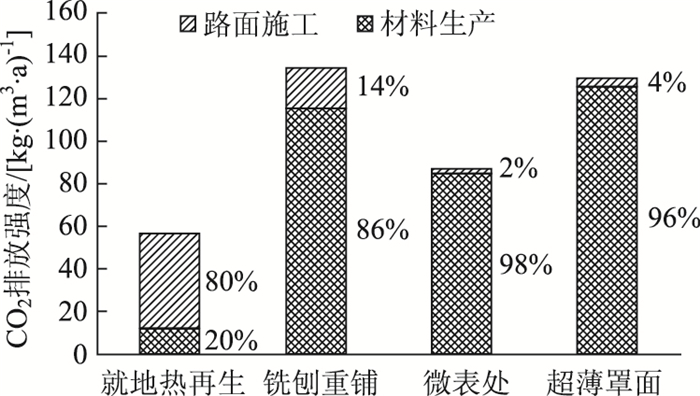扩展功能
文章信息
- 柴明明, 李明, 齐桂才, 王腾
- CHAI Ming-ming, LI Ming, QI Gui-cai, WANG Teng
- 就地热再生沥青路面建设期碳排放分析
- Analysis of Carbon Emission during Hot In-place Recycling Asphalt Pavement Construction
- 公路交通科技, 2016, 33(10): 148-151
- Journal of Highway and Transportation Research and Denelopment, 2016, 33(10): 148-151
- 10.3969/j.issn.1002-0268.2016.10.023
-
文章历史
- 收稿日期: 2016-05-24
2. 江西赣粤高速公路股份有限公司九景高速公路管理处, 江西 九江 332000;
3. 上饶市公路管理局婺源分局, 江西 上饶 333200
2. Jiujiang Expressway Administration of Jiangxi Ganyue Expressway Co., Ltd., Jiujiang Jiangxi 332000, China;
3. Wuyuan Branch of Shangrao Highway Administration, Shangrao Jiangxi, 333200, China
目前,全球性能源紧张及气候变化已成为社会普遍关注的重大问题,节能减排已成为国际社会的共同责任。我国“十二五”期间道路建设沥青混合料的年需求量超过1亿t,CO2年排放量达到450万t[1],随着道路大范围的进入维修期,传统的铣刨重铺方法会造成大量材料废弃、环境污染、碳排放量急剧增加。2020年全国公路路面旧料循环利用率要达到90%以上[2],近年来新兴路面维修养护工艺如就地热再生技术可100%回收利用原沥青路面旧料,此技术可在提高资源利用率的同时减少碳排放。
国内外主要采用生命周期分析方法(LCA)开展道路碳排放的量化分析研究,基于LCA和Darrell Cass[3]等研究了一条州际干线公路大修工程中材料生产、运输和机械施工的能耗及环境影响;Qazi Aurangzeb[4]等分析了旧沥青混合料含量对环境的影响,包括能量消耗和温室气体的排放;尚春静[5]等研究了高速公路水泥混凝土路面在建筑材料生产、建造、养护和拆除废弃4个阶段能耗和排放;王贤卫[6]等研究了高速公路建设过程中路基、路面、桥涵和隧道工程在材料生产、材料运输和机械施工3个阶段的CO2排放。这些研究主要集中在新建道路的碳排放,针对就地热再生沥青路面建设期的碳排放并无具体研究。
本文采用生命周期分析方法,采取碳排放系数与活动数据相乘原理,建立就地热再生沥青路面建设期碳排放计算模型,结合工程实例计算路面建设期碳排放,量化不同新料掺比、不同旧料运距及利用率下的碳排放,对比分析4种常用高速公路沥青路面养护技术的碳排放。
1 就地热再生建设期碳排放计算模型基于生命周期分析法,就地热再生沥青路面的建设期界定为材料生产和路面施工两阶段,见图 1,建设期碳排放的计算模型包括两阶段的碳排放总和。

|
(1) |

|
(2) |

|
(3) |

|
| 图 1 就地热再生沥青路面建设过程划分 Fig. 1 Division of hot in-place recycling asphalt pavement construction process |
| |
式中,P,Pcl,Psg分别为就地热再生沥青路面建设期、材料生产阶段、路面施工阶段碳排放量;mi为原材料的使用量;si为原材料的碳排放系数;i为各种原材料;n为原材料种类数;mj为加热路面的总量;ΔT为路面升高的温度;p为加热机碳排放系数;xj,ms为施工机械活动数据;vj,fs为施工机械碳排放系数;j,s为各路面施工机械;t,u为施工机械种类数。
2 工程实例结合某高速公路就地热再生沥青路面试验路工程,通过分析碳排放系数和活动数据,计算路面建设期的碳排放。
2.1 碳排放系数通过各能源缺省排放因子[7]和净发热值[8],考虑目前我国的发电情况[9],结合CO2,CH4,N2O的全球变暖潜值,得到以CO2为计算代表的能源的碳排放系数:柴油3.171 kg/kg,汽油2.996 kg/kg,重油3.247 kg/kg,电能0.785 kg/(kW·h)。
查阅相关文献[10-15]得到建设期各过程的能源消耗量,结合能源的碳排放系数,计算得到各过程碳排放系数见表 1。
| 阶段 | 过程 | 碳排放系数 |
| 材料生产阶段 | SBS改性沥青生产 | 315.77 kg/t |
| 集料生产 | 2.36 kg/t | |
| 沥青运输(10 t以内) | 159.49 kg/台班 | |
| 集料运输(10 t以内) | 175.44 kg/台班 | |
| 混合料拌和(60 t/h) | 6 864.15 kg/台班 | |
| 混合料运输(15 t以内) | 215.30 kg/台班 | |
| 路面施工阶段 | 加热机 | 0.092 5 kg/(t·℃) |
| 铣刨机 | 2.58 kg/t | |
| 复拌机 | 2.11 kg/t | |
| 摊铺机(4.5 m以内) | 133.38 kg/台班 | |
| 光轮压路机(15 t以内) | 256.62 kg/台班 | |
| 振动压路机(15 t以内) | 256.62 kg/台班 | |
| 轮胎压路机(16~20 t) | 134.12 kg/台班 |
2.2 活动数据
就地热再生沥青路面试验路工程完成路面实体1 210.64 m3,再生后路面密度2.475 t/m3,新料掺比10%,新料沥青含量5.1%,沥青、集料、混合料运距分别为70, 27, 45 km。再生设备为鞍山森远集团的SY4500再生机组(3台加热机、1台铣刨机和1台复拌机),摊铺机使用的是4.5 m以内的摊铺机,光轮压路机和振动压路机使用的是15 t以内、轮胎压路机为16~20 t。
3 工程实例碳排放分析 3.1 就地热再生沥青路面建设期碳排放分析由图 2可知,就地热再生沥青路面试验路工程材料生产和路面施工阶段产生碳排放占建设期总排放的20%和80%,路面施工阶段是就地热再生沥青路面建设期碳排放的主要组成部分。材料生产阶段的碳排放主要集中在原材料的生产和混合料的拌和,碳排放占比39%和41%;路面施工阶段的碳排放主要来源于就地热再生设备(加热机、铣刨机、复拌机),碳排放占比90%,其中加热机产生碳排放占比66%。从碳排放角度来看,需选用高效节能的就地热再生机组。

|
| 图 2 就地热再生沥青路面建设期碳排放 Fig. 2 Carbon emission of hot in-place recycling asphalt pavement construction |
| |
3.2 不同新料掺比下碳排放分析
就地热再生技术可以实现旧料的100%利用,但新料的掺量却根据工程而定,不同新料掺比下1 000 m3路面实体产生的碳排放见图 3,可知新料掺比为15%,10%,5%时碳排放分别为63 153,56 601,50 688 kg,碳排放增长率与新料掺比呈线性正相关,新料掺比提高1%,碳排放增加2%。

|
| 图 3 就地热再生沥青路面不同新料掺比下的碳排放 Fig. 3 Carbon emission of hot in-place recycling asphalt pavement with different new material ratios |
| |
3.3 不同旧料运距及利用率下的碳排放分析
厂拌热再生碳排放随旧料运距增大而逐渐增加,就地热再生是在现场100%利用旧料,碳排放保持不变。1 t旧料不同运距及利用率下产生的碳排放见图 4,就地热再生产生碳排放20 kg。

|
| 图 4 旧料不同运距及利用率下的碳排放 Fig. 4 Carbon emission with different old material haul distances and utilization rates |
| |
(1) 旧料利用率100%的厂拌热再生在旧料运距为0时产生碳排放10 kg,当运距为42 km时,厂拌和就地热再生产生碳排放相等。从碳排放环保角度出发,只有当运距大于42 km时,就地热再生才有优势。
(2) 旧料运距为0时,旧料利用率为70%,80%,90%的厂拌热再生产生碳排放为22,18,14 kg,碳排放增长量与旧料利用率呈线性负相关,利用率减少10%,碳排放增加4 kg,采用内插法,得到旧料利用率为75%的厂拌热再生产生碳排放为20 kg,和就地热再生产生碳排放相等。故旧料利用率低于75%时,无论运距长短,就地热再生比厂拌热再生更具有减排优势。
3.4 不同养护技术碳排放对比分析选取3种常用高速公路沥青路面养护技术进行碳排放对比分析,分别是铣刨重铺技术、超薄罩面技术和微表处技术,分析设定:
(1) 铣刨重铺技术,工程量1 210.64 m3,新料2 996.33 t,沥青含量4.8%,粘层油用量0.464 kg/m3,运距115 km。铣刨机采用维特根2 000,旧料运距11 km,预计使用寿命4 a。
(2) 超薄罩面技术,采用NovaChip® Type-B级配,工程量605.32 m3,新料1 498.17 t,沥青含量5.0%,粘层油用量0.8 kg/m2。罩面机械为中交西筑ZT600型专用摊铺机,预计使用寿命4 a。
(3) 微表处技术,采用MS-3级配,工程量272.39 m3,矿料用量18 kg/m2,其他材料用量为沥青:填料(水泥):水:矿料=7.2:1.5:10:100,施工机械为河南高远HGY5311TXJ微表处摊铺车,预计使用寿命3 a。
就地热再生路面的预计使用寿命为3 a,4种常用高速公路沥青路面养护技术的碳排放强度见图 5,就地热再生的碳排放强度为19 kg/(m3·a),为4种技术最少,其次是微表处、超薄罩面,产生碳排放最多的是铣刨重铺。微表处、超薄罩面和铣刨重铺技术碳排放强度增幅分别为53%,72%和79%。

|
| 图 5 4种养护技术碳排放强度 Fig. 5 Carbon emission of 4 maintenance technologies |
| |
铣刨重铺、超薄罩面和微表处建设期的碳排放主要来源于材料生产阶段,与就地热再生相反,主要原因是就地热再生百分百利用路面旧料,减少了原材料的生产和运输。
4 结论本文就地热再生沥青路面建设期划分为材料生产和路面施工两个阶段,采用LCA方法,建立了碳排放计算模型,结合工程实例计算了建设期的碳排放,主要结论如下:
(1) 案例计算结果显示,材料生产和路面施工阶段产生的碳排放分别占建设期总碳排放的20%和80%,路面施工阶段的碳排放主要来源于就地热再生设备尤其是加热机,材料生产阶段的碳排放主要来自原材料的生产和混合料的拌和。
(2) 就地热再生技术碳排放增长率与新料掺比呈线性正相关,新料掺比每提高1%,碳排放增加2%。
(3) 就地热再生技术利用1 t旧料产生碳排放20 kg。旧料100%利用的厂拌热再生与就地热再生碳排放相等时的旧料临界运距为42 km,当旧料运距高于42 km时,就地热再生比厂拌热再生才有优势。随着旧料利用率减少,临界运距随着缩短,旧料75%利用的厂拌热再生临界运距减少为0 km,无论运距长短,就地热再生比厂拌热再生有优势。
(4) 路面建设期碳排放强度:就地热再生<微表处<超薄罩面<铣刨重铺。就地热再生碳排放强度为19 kg/(m3·a),微表处、超薄罩面和铣刨重铺技术碳排放增幅分别为53%,72%和79%。
| [1] | 吴军伟. 道路工程碳排放量计算与分析模型的发展与应用[J]. 城市道桥与防洪 , 2011 (7) : 248-250 WU Jun-wei. Development and Applications of Carbon Emissions Calculation and Analysis Models in Road Engineering[J]. Urban Roads Bridges & Floods Control , 2011 (7) : 248-250 |
| [2] | 交通运输部.关于加快推进公路路面材料循环利用工作的指导意见[EB/OL].[2012-09-27]. http://www.mot.gov.cn/sj/gonglj/gongluyh_glj/201408/t20140813_1668887.html. Ministry of Transport. Work Guidance on Accelerating Utilization of Recycling Road Pavement Material[EB/OL].[2012-09-27]. http://www.mot.gov.cn/sj/gonglj/gongluyh_glj/201408/t20140813_1668887.html. |
| [3] | ZAPATA P, GAMBATESE J A. Energy Consumption of Asphalt and Reinforced Concrete Pavement Materials and Construction[J]. Journal of Infrastructure Systems , 2005, 11 (1) : 9-20 |
| [4] | AURANGZEB Q, AL-QADI I L, OZER H, et al. Hybrid Life Cycle Assessment for Asphalt Mixtures with High RAP Content. Resources[J]. Resources Conservation & Recycling , 2014, 83 (1) : 77-86 |
| [5] | 尚春静, 张智慧, 李小冬. 高速公路生命周期能耗和大气排放研究[J]. 公路交通科技 , 2010, 27 (8) : 149-154 SHANG Chun-jing, ZHANG Zhi-hui, LI Xiao-dong. Research on Energy Consumption and Emission of Life Cycle of Expressway[J]. Journal of Highway and Transportation Research and Development , 2010, 27 (8) : 149-154 |
| [6] | 王贤卫, 吴灵生, 杨东援. 高速公路建设CO2排放计算分析[J]. 公路交通科技 , 2014, 31 (2) : 150-158 WANG Xian-wei, WU ling-sheng, YANG dong-yuan. Calculation and Analysis of CO2 Emission from Expressway Construction[J]. Journal of Highway and Transportation Research and Development , 2014, 31 (2) : 150-158 |
| [7] | IPCC National Greenhouse Gas Listing Task Force. IPCC2006, IPCC Guidelines for National Greenhouse Gas Inventories[M]. Kanagawa, Japan: Institute for Global Environmental Strategies, 2006 . |
| [8] | GB-T2589-2008, 综合能耗计算通则[S]. GB-T2589-2008, General Principles for Calculation of Total Production Energy Consumption[S]. |
| [9] | 交通运输部.节能减排量或投资额核算技术细则(第二部分)[EB/OL].[2014-04-04]. http://jnzx.mot.gov.cn/gongaotongzhi/201404/t20140404_1601780.html. Ministry of Transport. Energy-saving and Emission-reduction or Investment Accounting Rules (Part Ⅱ)[EB/OL].[2014-04-04].http://jnzx.mot.gov.cn/gongaotongzhi/201404/t20140404_1601780.html. |
| [10] | HJ443-2008, 清洁生产标准-石油炼制业(沥青)[S]. HJ443-2008, Cleaner Production Standard-Petroleum Refinery Industry(Bitumen)[S]. http://www.docin.com/p-67612784.html |
| [11] | 章毅.沥青路面生命周期能耗与环境排放评价技术研究[R].上海:同济大学, 2014. ZHANG Yi. Research on Assessment Technology of Asphalt Pavement Life Cycle Energy Consumption and Environmental Emissions[R]. Shanghai:Tongji University, 2014. http://www.cnki.com.cn/article/cjfdtotal-glgl201501020.htm |
| [12] | STRIPPLE H. Life Cycle Inventory of Asphalt Pavements[M]. Gothenburg: IVL Swedish Environmental Research Institute Ltd, 2001 . |
| [13] | JTG/T B06-02-2007, 公路工程预算定额[S]. JTG/T B06-02-2007, Highway Engineering Budget Quota[S]. http://www.oalib.com/references/16414615 |
| [14] | JTG/T B06-03-2007, 公路工程机械台班费用定额[S]. JTG/T B06-02-2007, Highway Engineering Machine-team Budget Quota[S]. http://www.doc88.com/p-704873048551.html |
| [15] | 任淑晶, 齐广田. SY4500型沥青路面就地热再生重铺机组[J]. 工程机械 , 2009, 40 (6) : 18-19 REN Shu-jing, QI Guang-tian. Model SY4500 Hot-in-place Reclamation and Repaving Machine Train for Asphalt Pavements[J]. Construction Machinery and Equipment , 2009, 40 (6) : 18-19 |
 2016, Vol. 33
2016, Vol. 33
